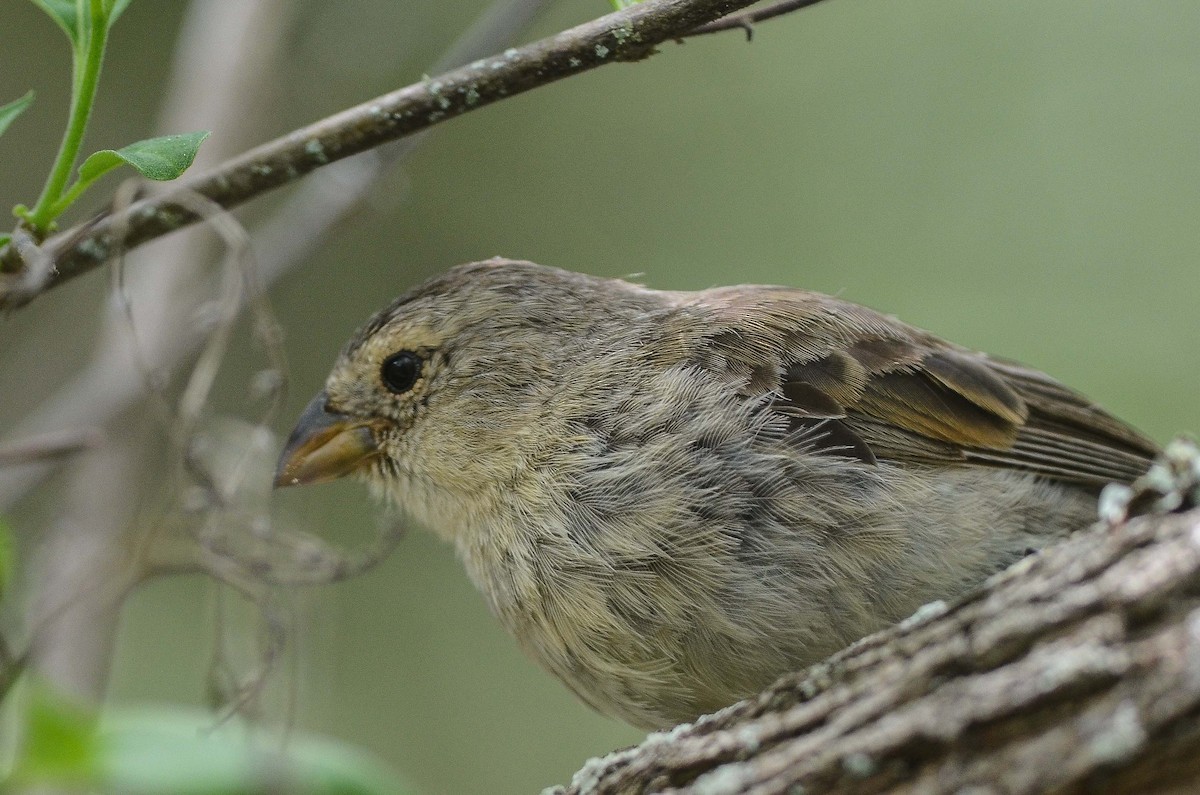Woodpecker Finch
A species of Tree Finches Scientific name : Camarhynchus pallidus Genus : Tree Finches
Woodpecker Finch, A species of Tree Finches
Botanical name: Camarhynchus pallidus
Genus: Tree Finches
Content
Description General Info
 Photo By Nikolaj Mølgaard Thomsen
Photo By Nikolaj Mølgaard Thomsen Description
Woodpecker finches range in weight from 23g to 29g and are about 15 cm long. Although their tongues are quite short, they have a relatively long bill compared to other species of Darwin's finches. 
Size
15 cm
Nest Placement
Cavity
Feeding Habits
Woodpecker Finch primarily consume arthropods like insects, larvae, and beetles, extracting them from tree crevices. They uniquely use tools to forage and also eat fruit and seeds, aiding in seed dispersal.
Habitat
The woodpecker Finch thrives in diverse habitats, predominantly residing in the montane evergreen forests. It favors the transition zones to higher humidity forested areas, which provide the ecological conditions necessary for its survival and reproduction.
Dite type
Insectivorous
General Info
Feeding Habits
Bird food type
Behavior
One of the most distinguishable traits of Camarhynchus pallidus which has caused it to gain fame, is its ability to use a twig, stick, or cactus spine as a tool. This behaviour earned it the nicknames tool-using finch, and carpenter finch. The tool is used as compensation for its short tongue. The finch manipulates the tool to dislodge invertebrate prey, such as grubs, from crevices in trees. It has been hypothesized that woodpecker finches filled a niche, similar to that of woodpeckers, on the Galapagos Islands. Woodpeckers have strong bills for drilling and drumming on trees, as well as long sticky tongues for extracting food. On the isolated Galapagos islands, without competition from South American woodpecker species, the woodpecker finch was able to adapt, and evolve its tool-utilizing capability to compensate for its short tongue. The ability to use tools is a highly specialized cognitive ability as it involves the animal creating and recognizing a relationship between two foreign objects found in its environment. Woodpecker finches are capable of using a variety of materials to construct the tools they use. They are capable of modifying the tools they find in order to maximize their efficiency. Scientists have observed finches shortening the length of sticks or cactus spines in order to make them more manageable for tool use. The same tool can be used multiple times and on different trees. Woodpecker finches may also try various sticks or spines at one site before finding one that can reach and extract the prey item. There is conflicting evidence of whether or not this behaviour was acquired through social learning, as juveniles have been observed using tools without previous contact with adults. In contrast, juvenile woodpecker finches have also been observed utilizing novel tools made from non-native plant species, such as blackberry bushes. After observing adult woodpecker finches prep barbed twigs and use them to obtain prey from crevices in trees, juvenile finches displayed the same behaviour with the novel tool. These observations contrasted previous studies to show that social learning may occur in wild woodpecker finch populations. The frequency of tool use by woodpecker finches depends largely on whether they live in a more wet or dry environment. Woodpecker finches that live in more wet environments seldom use tools as prey is much more abundant. In contrast, they employ tool use much more when living in dry areas. During the dry season, woodpecker finches use tools while foraging to acquire up to 50% of their prey. The use of tools has allowed woodpecker finches to be able to obtain prey that they would otherwise be unable to reach with their short tongues. It is thought that this behaviour came to evolve due to the harshness of the dry and unstable environmental conditions of the Galapagos Islands. 
Distribution Area
Woodpecker finches are native to the Galapagos Islands. They are commonly found on the islands of Isabela, Santa Cruz, San Cristobal, Fernandina, Santiago, and Penzón. They occupy all areas of the islands, from the most arid zones to more humid zones. However, the density of woodpecker finches is greater in the more humid zones than in the drier ones. Woodpecker finches are also found at a variety of altitudes, from sea level to higher inland elevations. They are a not a migratory species and when they do fly, they only fly short distances. 

 Photo By Nikolaj Mølgaard Thomsen
Photo By Nikolaj Mølgaard Thomsen Scientific Classification
Phylum
Chordates Class
Birds Order
Perching birds Family
Tanagers Genus
Tree Finches Species
Woodpecker Finch